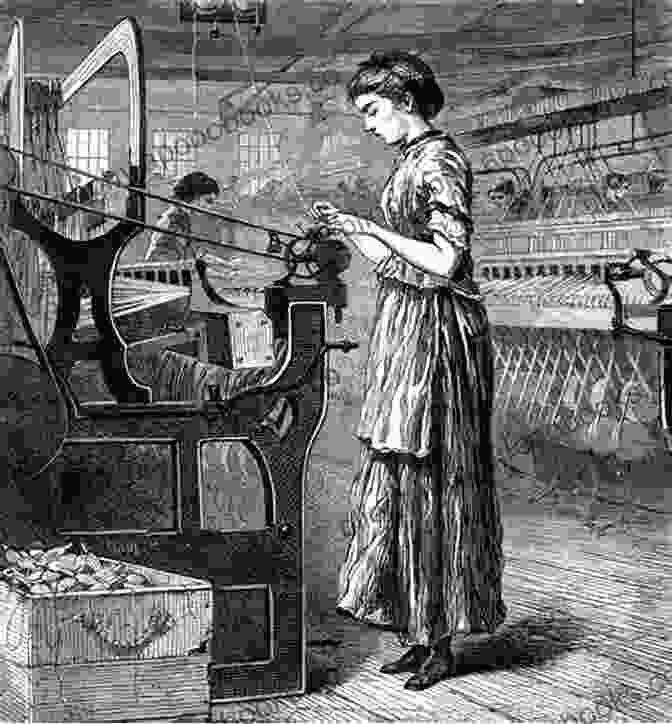Women Workers and Technological Change in Europe in the Nineteenth and Twentieth Centuries


4.4 out of 5
| Language | : | English |
| File size | : | 3871 KB |
| Text-to-Speech | : | Enabled |
| Enhanced typesetting | : | Enabled |
| Word Wise | : | Enabled |
| Print length | : | 225 pages |
| Screen Reader | : | Supported |
| Item Weight | : | 6.3 ounces |
The 19th century witnessed a profound transformation in European society as industrialization swept across the continent. This technological revolution had a significant impact on all sectors of the economy, including the labor market. Women, who had traditionally been confined to domestic roles, began to enter the workforce in increasing numbers as new industries emerged and new jobs were created.
This article explores the impact of technological change on women workers in Europe during the 19th and 20th centuries. It examines the different types of jobs that women were able to obtain, the challenges they faced in the workplace, and the ways in which technological advancements affected their social and economic status.
Women's Employment in the 19th Century
Prior to the Industrial Revolution, most women worked in agriculture or in domestic service. However, as factories and other industries began to spring up, new opportunities for women in the labor market emerged.
Women were initially employed in low-skilled jobs that required little training or education. These jobs typically involved repetitive tasks, such as spinning, weaving, and sewing. However, as technology advanced, women began to move into more skilled positions, such as operating machinery and working as clerks and typists.
The textile industry was one of the first to employ large numbers of women. In Britain, for example, women made up over half of the workforce in the textile mills by the mid-19th century. Women also found work in other industries, such as food processing, clothing manufacturing, and metalworking.
Challenges Faced by Women Workers
Women workers faced a number of challenges in the workplace. They were often paid less than men for the same work, and they were more likely to be laid off during economic downturns. They also faced discrimination and harassment from male supervisors and coworkers.
In addition, women often had to balance their work responsibilities with their domestic duties. This could be a difficult task, especially for women who had young children.
Despite these challenges, women continued to enter the workforce in increasing numbers. By the end of the 19th century, women made up a significant proportion of the labor force in many European countries.
The Impact of Technological Change
Technological change had a significant impact on women workers in the 19th and 20th centuries. On the one hand, new technologies created new jobs and opportunities for women. On the other hand, technological advancements also led to the displacement of some jobs that had traditionally been held by women.
For example, the invention of the sewing machine led to a decline in the number of women employed as seamstresses. Similarly, the invention of the typewriter led to a decline in the number of women employed as copyists.
However, technological change also created new jobs for women. For example, the invention of the telephone led to the creation of new jobs for women as telephone operators. Similarly, the invention of the computer led to the creation of new jobs for women in the IT industry.
Overall, the impact of technological change on women workers was mixed. While some jobs were lost to automation, new jobs were also created. The overall effect was to increase the number of women in the workforce and to improve their economic status.
The 19th and 20th centuries witnessed a profound transformation in the role of women in European society. The Industrial Revolution led to the emergence of new industries and new jobs, and women began to enter the workforce in increasing numbers. Technological change had a significant impact on women workers, both positive and negative. Overall, however, the impact of technological change was to increase the number of women in the workforce and to improve their economic status.
Today, women make up a significant proportion of the labor force in all developed countries. They work in a wide range of occupations, from low-skilled jobs to high-skilled professions. Technological change continues to have an impact on women workers, but the overall trend is towards greater equality in the workplace.
4.4 out of 5
| Language | : | English |
| File size | : | 3871 KB |
| Text-to-Speech | : | Enabled |
| Enhanced typesetting | : | Enabled |
| Word Wise | : | Enabled |
| Print length | : | 225 pages |
| Screen Reader | : | Supported |
| Item Weight | : | 6.3 ounces |
Do you want to contribute by writing guest posts on this blog?
Please contact us and send us a resume of previous articles that you have written.
 Book
Book Novel
Novel Page
Page Chapter
Chapter Text
Text Story
Story Genre
Genre Reader
Reader Library
Library Paperback
Paperback E-book
E-book Magazine
Magazine Newspaper
Newspaper Paragraph
Paragraph Sentence
Sentence Bookmark
Bookmark Shelf
Shelf Glossary
Glossary Bibliography
Bibliography Foreword
Foreword Preface
Preface Synopsis
Synopsis Annotation
Annotation Footnote
Footnote Manuscript
Manuscript Scroll
Scroll Codex
Codex Tome
Tome Bestseller
Bestseller Classics
Classics Library card
Library card Narrative
Narrative Biography
Biography Autobiography
Autobiography Memoir
Memoir Reference
Reference Encyclopedia
Encyclopedia Lexi Post
Lexi Post Eliza Earsman
Eliza Earsman John A Cassara
John A Cassara George East
George East Gilda L Ochoa
Gilda L Ochoa Ivelin Demirov
Ivelin Demirov Deborah Rambo Sinn
Deborah Rambo Sinn Tech Reviewer
Tech Reviewer Henry M Robert
Henry M Robert Deborah M Poole
Deborah M Poole Stefan Weidner
Stefan Weidner Lisa Carlisle
Lisa Carlisle David Scott Kastan
David Scott Kastan Ezra Bayda
Ezra Bayda Dr Hulk
Dr Hulk Ruby K Payne
Ruby K Payne Vinayak Chaturvedi
Vinayak Chaturvedi Valerie M Pontbriand
Valerie M Pontbriand Itzhak Brook M D
Itzhak Brook M D Linda Boulanger
Linda Boulanger
Light bulbAdvertise smarter! Our strategic ad space ensures maximum exposure. Reserve your spot today!

 Bradley DixonUnleash the Darkness and Delve into the Unfathomable: "Through Dark Silence"
Bradley DixonUnleash the Darkness and Delve into the Unfathomable: "Through Dark Silence"
 Clarence MitchellUnleash the Epic Battle Hymn Cycle: A Literary Triumph That Will Captivate...
Clarence MitchellUnleash the Epic Battle Hymn Cycle: A Literary Triumph That Will Captivate... Clay PowellFollow ·4k
Clay PowellFollow ·4k Charles BukowskiFollow ·6.2k
Charles BukowskiFollow ·6.2k Kirk HayesFollow ·17.2k
Kirk HayesFollow ·17.2k Herb SimmonsFollow ·4.4k
Herb SimmonsFollow ·4.4k Sean TurnerFollow ·2.2k
Sean TurnerFollow ·2.2k Lord ByronFollow ·10.7k
Lord ByronFollow ·10.7k Quentin PowellFollow ·4.4k
Quentin PowellFollow ·4.4k Arthur C. ClarkeFollow ·8.2k
Arthur C. ClarkeFollow ·8.2k

 Finn Cox
Finn CoxEmpowering School-Based Professionals: A Comprehensive...
: The Role of School-Based Professionals in...

 F. Scott Fitzgerald
F. Scott FitzgeraldThe Santa Fe Trail Twentieth Century Excursion: A...
Get ready to embark on an...

 Kendall Ward
Kendall WardThe Ultimate Trivia Guide to Bruce Springsteen and the...
Bruce Springsteen...

 Jedidiah Hayes
Jedidiah HayesThe Trouble with Lacy Brown: Texas Matchmakers - A...
Prepare to be swept...
4.4 out of 5
| Language | : | English |
| File size | : | 3871 KB |
| Text-to-Speech | : | Enabled |
| Enhanced typesetting | : | Enabled |
| Word Wise | : | Enabled |
| Print length | : | 225 pages |
| Screen Reader | : | Supported |
| Item Weight | : | 6.3 ounces |












